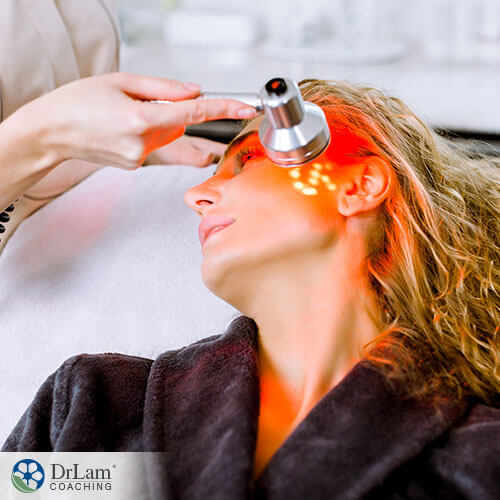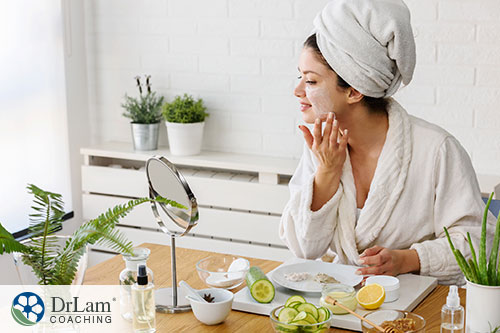 Light has been used therapeutically for a long time, and there are different techniques out there, each one with a purported use and benefit. One of them is called Red Light Therapy. It was first used for non-medical reasons, such as for growing plants. In the 1990s, some scientists even used it to grow plants in space by using red LEDs, which supported the photosynthesis process. However, it has also been used for skin care and anti-aging purposes, and it may show some promise.
Light has been used therapeutically for a long time, and there are different techniques out there, each one with a purported use and benefit. One of them is called Red Light Therapy. It was first used for non-medical reasons, such as for growing plants. In the 1990s, some scientists even used it to grow plants in space by using red LEDs, which supported the photosynthesis process. However, it has also been used for skin care and anti-aging purposes, and it may show some promise.
Red light therapy has also been called soft laser therapy, low-power laser therapy, cold laser therapy, low-level light therapy, photonic stimulation, and biostimulation. This therapy uses low-level wavelengths, and it’s a non-invasive therapy with very few side-effects. Unfortunately, there haven’t been enough studies conducted on its effectiveness, so it still remains a somewhat controversial method.
Still, it has been shown to provide some benefits for beauty and anti-aging as well as medically, especially dermatologically, either as a direct therapy for certain conditions or as a support for other therapies and medications.
Even though the skin is the organ most exposed to natural red light, it can still benefit a lot from additional red light therapy, which can penetrate the skin up to five millimeters.
The way it works is that the skin’s mitochondrial chromophores absorb the photons emitted by the red light, helping to increase adenosine triphosphate (ATP) production, which is the energy currency of life. It also increases the production of free radicals, intracellular calcium, and nitric oxide, as well as increases blood flow.
This therapy also activates stem cells and different signaling pathways – translocating transcription factors to the nuclei of skin cells where they activate gene transcription, which can help with cell survival, faster wound healing, and tissue repair.
The visible benefits of this for the skin include the reduction of wrinkles, acne scars, stretch marks, and other types of scars. It can also stimulate the proliferation of melanin-producing cells, supporting the re-pigmentation of the skin in those with vitiligo. It can also slow down or prevent the depigmentation process in those with the condition.
With faster healing, issues such as diabetic foot ulcers, psoriasis lesions, burn wounds, and sun damage can also be helped.
What’s different about red light therapy compared to other forms, such as laser therapy for example, is that it does not stimulate the repair process in the cells by first causing damage to them. In therapies that use this technique, the damage triggers the cells to go into the repair process when they would have otherwise not have done so.
Other benefits of red light therapy that have some evidence to back them up include:
 Your skin is your largest organ, and it has many functions, including protecting you from the elements, temperature regulation, and detoxification. Keeping it healthy and in good condition can go a long way, not only in improving your external appearance, but also in achieving and maintaining internal health.
Your skin is your largest organ, and it has many functions, including protecting you from the elements, temperature regulation, and detoxification. Keeping it healthy and in good condition can go a long way, not only in improving your external appearance, but also in achieving and maintaining internal health.
The skin is part of what makes your body a closed system that maintains homeostasis, which is the relatively stable equilibrium between its different physiological processes. One important thing that needs to be kept running smoothly if your body is to stay as close to homeostasis as possible is the clearance of toxins, pathogens, and metabolic byproducts from your system in a timely fashion.
These substances have several channels through which they are cleared including the bowels, kidneys, lungs, and skin. But before they are excreted, they are first stored and processed through the Detoxification circuit of your NeuroEndoMetabolic (NEM) Stress Response.
Your NEM is your body’s global response to stress, and it’s composed of six circuits of organs and systems that work together to fight stress: The Hormone, the Bioenergetics, the Neuroaffect, the Cardionomic, the Inflammation, and the Detoxification circuits.
Your Detoxification circuit is composed of the immune system, the liver, and the interstitium (or extracellular matrix). Each of these three components fulfills a role in the detoxification process.
The immune system attacks any intruders or abnormal cells that can cause harm to the body, creating inflammation and initiating the repair process once the original insult has been dealt with.
The liver, which is your body’s main clearinghouse, contains many immune system cells and is the most active organ in the Detoxification circuit. It neutralizes toxins (including metabolites) through a two-step mechanism. First, it turns fat-soluble toxins into water-soluble metabolites. Then, it takes these metabolites and renders them inactive. These inactive metabolites can then be excreted from the body without causing harm as they pass through the excretion organs, such as the skin.
The interstitium is a network of paths that the substances being detoxified travel through on their way to the liver for processing or on their way from the liver to be excreted.
Dysfunction in this process can create a build-up of these substances in the system, raising the toxicity level and even damaging some of the organs and systems involved. Therefore, ensuring that each organ and system involved in detoxification is in optimal condition is one way to keep your system clean and clear from toxins.
There is some anecdotal evidence that red light therapy can help with boosting the immune system and stimulating the lymphatic system to detoxify. And although these can be useful in keeping the Detoxification circuit functioning well, its benefits for the skin may trump these uses in helping the skin withstand the process of excreting metabolites without becoming inflamed or damaged.
 An important factor in skin health, as well as the health of the NEM, is how much stress you’re under. Although your body was made to handle acute stress from time to time, it was not made to handle chronic stress, which is fast becoming a main feature in modern life. Chronic stress, whether physical, such as an unhealthy diet or recurring infections, or psychological, such as being in a toxic relationship or having financial pressure, affects the body in a major way.
An important factor in skin health, as well as the health of the NEM, is how much stress you’re under. Although your body was made to handle acute stress from time to time, it was not made to handle chronic stress, which is fast becoming a main feature in modern life. Chronic stress, whether physical, such as an unhealthy diet or recurring infections, or psychological, such as being in a toxic relationship or having financial pressure, affects the body in a major way.
The first line of defense against stress is your adrenal glands, which are part of the Hormone circuit of your NEM. They fight a stressor by producing your body’s most important anti-stress hormone, cortisol. If the stress is chronic, your cortisol levels will become higher than normal for a while as your adrenal glands work hard to meet the growing demand for it. But after some time, the adrenals become exhausted and their cortisol output drops.
Both of these situations are phases of Adrenal Fatigue Syndrome (AFS), which can lead to symptoms such as fatigue, weight gain, brain fog, insomnia, anxiety, mild depression, loss of libido, PMS, infertility, hypoglycemia, lowered immunity, heart palpitations, hair loss, and dry skin.
With regards to skin, there are several stressors to be aware of, such as sun exposure, which can increase the presence of free radicals and cause oxidative damage, inflammation (either due to a bad diet or from infections and toxicity), congestion from slowed detoxification, dehydration, dysbiosis in the skin’s microbiome, hormonal dysregulation, and the effects of elevated cortisol.
Many of these issues can accompany AFS, and fall under the responsibility of the NEM’s stress response. So anything you can do to not only support your adrenal glands and your NEM, but also to avoid or reduce such stressors, is a good way to keep your skin healthy. Topical creams and other types of therapy, including red light therapy, should be the support, not the main method of dealing with skin problems.
There are many ways to detoxify your system, but you should always make sure that you’re prudent in this undertaking, as detoxification can be hard on the body if it’s already under a lot of pressure. For example, if you have more advanced AFS, doing a detox of any kind may end up leading to a crash, as it can stress your system and cause the adrenals to become even more exhausted.
Also, some of the methods used in detoxification, such as more extreme forms of dietary cleanses, certain herbs and supplements, saunas, and light therapies that are a little more intense or invasive than red light therapy, can be a little too stressful on a weakened body. Even over-hydrating the body when you have advanced AFS can actually be detrimental, as it can disrupt the balance of certain minerals and electrolytes, such as the sodium-potassium balance.
If you have AFS or any other chronic condition, and you do decide to try any of the above, including red light therapy, which is usually harmless, you should only do so with the advice of a trusted and reputable practitioner. And you should only do so after you’ve already begun implementing other dietary and lifestyle changes that form the foundation of your recovery process.
© Copyright 2020 Michael Lam, M.D. All Rights Reserved.
Although red light therapy is still a little controversial, there are studies showing its beneficial effects on the skin’s healing, regeneration, and detoxification abilities. Plus, it’s a non-invasive, safe, and gentle method, so you don’t have to worry about negative side-effects.
